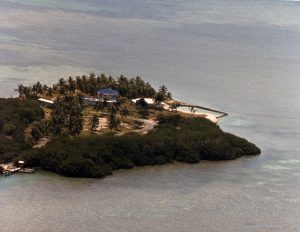
Aerial of Tea Table Key. Photo taken by the Federal Government on October 7, 1987. From the Wright Langley Collection.
Tea Table Key is part of five islands of Islamorada; the other four include Upper Matecumbe Key, Lower Matecumbe Key, Windley Key and Plantation Key. Islamorada is world famous for sports fishing. Tea Table Key lies to the south-west of Upper Matecumbe Key, and to the northeast of Lower Matecumbe Key.
Native Americans lived on Tea Table Island during prehistoric times (over 1,000 years ago), like nearby Lower and Upper Matecumbe and Indian Keys. The early inhabitants settled here to take advantage of the abundance of maritime resources available in the area. In 1838, Lt. Coste established a Naval Base here and named it Fort Paulding. This was the base where the West Indian Squadron was stationed to blockade the coast and keep the Native Americans from receiving supplies from the Bahamas or Cuba.
Gauld (1775) wrote: “The small key off the west end of New Matacumbe has a remarkable single tree at the south end of it like an umbrella.” Tea Table Key is the site of a former U.S. Navy depot and hospital, (Fort Paulding) most notably around the time of the Indian attack on Indian Key (1840). Once owned by Mr Howe, of Indian Key.
At the time of the attack on Indian Key, most of the naval contingent was away on patrol. An attempt was made to repel the Indians, by launching two barges, mounted with swivel guns, from Tea Table Key. The Native Americans fired at the barges using a six-pound cannon previously mounted on Indian Key by Jacob Houseman.
The Seminole Wars were the longest, and most expensive of all the Indian Wars in the U.S., Houseman’s island became endangered, and a military outpost was established on nearby Tea Table Key as protection. On August 7, 1840, a band of Indians led by a famous Indian Chief named Chekika landed on the island and attacked the settlers.
This is the only recorded instance of artillery being used by Indians against U.S. troops during any of the Indian wars.
There is a small public beach on the island and the entrance to a private road that leads to a residence. There are three beaches in Islamorada, Founder’s Park, John Pennekamp Coral Reef State Park and Anne’s Beach.
Historical names include Boys Key (1722), Umbrella Kay, Teatable Key, and Tea Table Kay. DeBrahm chart (1772) shows Boys. George Gauld, (1775) has Umbrella Kay. U.S. Navy papers are written in 1840 call the key Teatable. Blunt chart (1846) shows Umbrella Kay. Gerdes (1849) states: “Umbrella Kay is called Tea-Table Kay.”